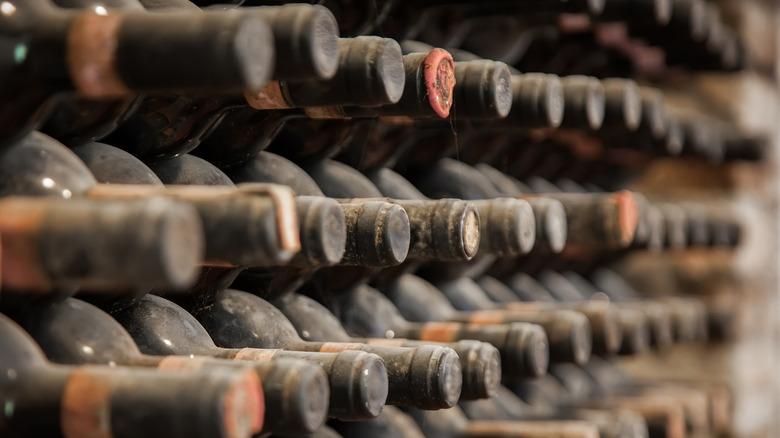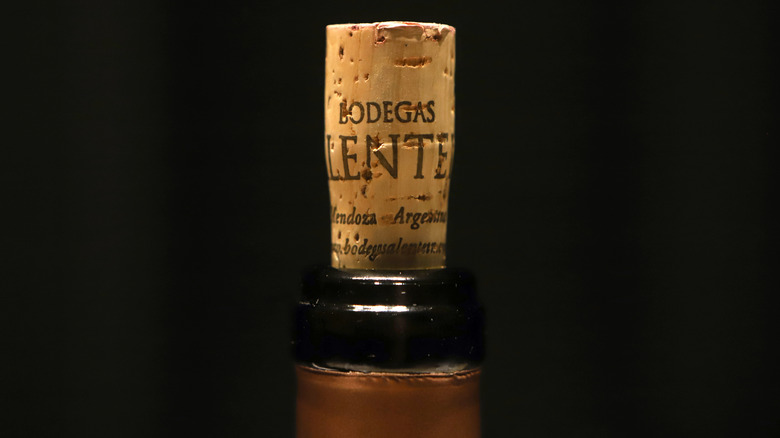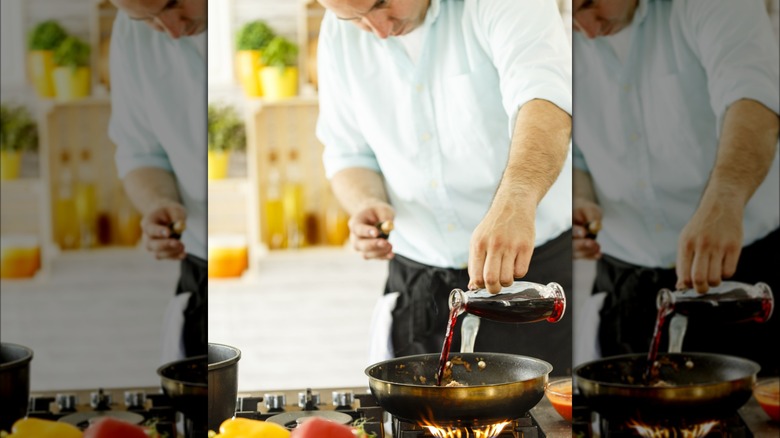How To Tell If Your Wine Has Gone Bad
There's nothing like picking up a new bottle of wine brimming with potential. But, proper storage sometimes gets swept to the side. In subpar conditions, wine can develop off aromas and faulty characteristics over time. Additionally, a product might be bottled in conditions that compromise its quality, which can taint a bottle with microorganisms and bacteria that will wreak havoc on the wine. Even if you open a bottle in pristine condition, after a bottle is opened, wine doesn't have an endless shelf life. There's no use stretching it out; savor over days or weeks and the last drop will be a disappointment.
Although most wine spoilage doesn't have the potential to affect your health, it can certainly affect morale, especially if you've been holding onto a bottle for years only to discover it has gone bad somewhere along the way. But how can you tell? What features clue you into the demise of a bottle? We'll highlight the key ways to identify your wine is well past its prime and offer a few tips to help avoid this sad fate.
Wine should be consumed within days of opening
Several factors influence the cellar life of a bottle, as well as the amount of time you can store an open bottle. Some grape varieties simply fare better than others and characteristics such as high tannins, acidity, or sugar all act to preserve the contents over time. Of course, even the most ageable wine won't last long if you're storing it in the kitchen on top of the refrigerator.
Meanwhile, once you open a bottle of wine, the clock starts ticking for its longevity. Oxygen and the process of oxidation immediately start to affect the contents. Flavors begin to taste flat, and the wine takes on a unidimensional aspect with nutty aromas. Wait a few weeks and it will turn into vinegar.
Sparkling wines progress the quickest, as their effervescence fades away after one to three days. Full-bodied whites and red wine last a little longer, reaching five days after being opened. On the other hand, lighter white wines and rosés have the advantage of typically containing a higher acidity level, which allows them to be fine for up to seven days.
You aren't likely to get sick from wine that's gone bad
The average bottle of wine that's been sitting around for a little too long isn't going to do much harm. You might even add a splash of it to your salad dressing for extra tang. As it turns out, wine has antimicrobial and antibacterial properties that can help fight against certain pathogens in food. The results of a 1995 study published in The BMJ found it to be more effective than Pepto Bismol in some cases of digestive trouble.
In a very unlikely circumstance, an open bottle of wine could develop the presence of microbes that are resistant to its properties and cause unpleasant symptoms of food poisoning, according to Medical News Today. That being said, considering wine's primary role as an antimicrobial agent, something really bad would have to find its way into the bottle. And, of course, if you polish off a bottle that has turned into vinegar, you probably won't feel great either.
Wine is off when the bottle is corked
While plenty of wine faults are only familiar to informed consumers and experts, the idea of a bottle being corked is more mainstream. Even if you aren't quite sure what that entails, the term corked wine is not a total mystery to the general public. You might assume that the problem stems from the cork and, in many instances, that is true.
However, the true culprit of a corked bottle of wine is a fungus that produces a chemical compound abbreviated as TCA and colloquially referred to as cork taint. The fungus typically grows on the tree bark, which is used to make cork stoppers. However, the compound can affect barrels, winery equipment, and even screw-top wines in some cases. As a result of contamination, the wine develops a musty wet dog kind of aroma. Think old basements and soggy newspapers.
Aside from the unpleasant odor, cork taint destroys any nuances in your wine. You won't taste the presence of fruit and the overall flavor will be dull. There are significant individual variations when it comes to detecting TCA, and naturally bolder wines tend to mask it a bit more. Considering it has a moldy background note, we might be evolutionarily predisposed to noticing the compound when it's present. Nevertheless, unlike moldy food, corked wine won't make you sick.
Wine smells or tastes mousey when it's gone bad
Musty basements and wet dogs are only the start of what a bad bottle of wine can smell like. Sulfur compounds known as mercaptans can introduce aromas of eggs, garlic, cabbage, burnt rubber, and matches. This can be caused by reduction, which occurs when winemaking takes place in the absence of oxygen. Decanting your bottle into another vessel can help some of the unpalatable aromas disperse.
Certain bacteria or microbes can also produce a taste reminiscent of a gerbil's cage or hay. The taste of gerbil cage is known as mousiness, which tends to occur with more frequency in natural wines that are unfiltered or lack added sulfites to stabilize the product. Some people actually like it in small amounts but anything more is a sure sign that your wine has gone bad.
Another common aspect that can signal spoiled wine in higher concentrations is brettanomyces or brett. This yeast causes aromas that bring barnyard animals to mind and, in some cases, a medicinal band-aid quality. While that doesn't sound great, in lower quantities it is responsible for some of the earthy rustic notes present in top wine regions in France, Italy, Spain, and California. In desirable doses, expect a gamey leather essence with a smoky undertone. If it tastes antiseptic, it's time to pour the bottle down the drain.
Bad wine tastes or smells like vinegar
Considering that wine in contact with oxygen becomes vinegar over time, it's no surprise that the taste will be affected. Sure, it might be pinot noir vinegar, but it's vinegar nonetheless. While oxygen is the medium of transmission, the actual culprit is a bacteria called acetobacter, which ultimately turns your wine into acetic acid, aka vinegar. It makes sense that an open bottle will eventually meet this fate, however, in some circumstances, the contents can be affected during the winemaking process. In this case, you'll remove the cork only to experience a sour whiff emanating from the bottle.
You're best off just emptying out a sour bottle, but if you're really set on drinking it, it's worth knowing that it won't be particularly harmful. You might feel the acidity after a couple of glasses, but there's nothing inherently damaging about drinking sour wine. Though, if you're really going for it, you might want to try mixing wine that tastes like vinegar into a cocktail to mask some of the tang.
Wine develops a cloudy appearance when it goes off
Disregarding unfiltered wines that have a naturally cloudy presentation, your once-clear wine shouldn't visually transform before you get through the bottle. If it goes from clear to murky, something else is up. A few elements could be at play, including yeast or bacterial activity that can grow on the wine prior to bottling and after it's been sitting open for a while. Oftentimes, the culprit is unclean winemaking equipment.
Bacterial and spoiled yeast contamination can occur in the absence of sulfites, which serve as a preservative for wine. For this reason, you'll want to consume sulfite-free wines more quickly once you open a bottle. Since it is a common allergen, wine labels must indicate the presence or absence of sulfites.
In the case of aged red wines, sediments from the tannin structure settle to the bottom of the bottle over time. When you pour a glass it causes them to float through the liquid, giving the appearance of some haziness. However, in these cases, the origin is clear and unrelated to bacteria. To avoid this issue, simply decant older bottles and leave the sediment behind.
Bad wine changes to a brown color
If you've ever left apple slices on the counter, then you've seen what happens when fruit oxidizes. Since wine is made from grapes, the liquid also oxidizes when exposed to oxygen. This can occur slowly over time or more quickly once a bottle has been opened and come in contact with the air. Red wines lighten and take on a brownish hue, while white wines darken and veer toward brown. If you're in the market for aged wine and a bottle of red looks closer to brown, you're best off dismissing it. Aside from altering the wine's vibrant color, oxidation can also dull the flavor, masking the fruit and introducing nuttier notes.
Oxidation isn't always the enemy; certain styles of wine place it front and center, such as sherry or vin jaune from Jura, France. As well, red wines with harsh tannins benefit from the soft touch of oxidation. In fact, it's the process that occurs — albeit slowly — when wine ages in oak barrels. All the same, you'll want to avoid putting your half-open bottle through the oxidation process by sealing it and consuming it within a few days.
Watch out if the cork of an unopened bottle moves
If you are storing wines longer term, temperature control is a key factor in guaranteeing their longevity. Aside from affecting the quality of the liquid in the bottle, shifts in temperature from warm to cold and vice versa can compromise the integrity of the cork. As wine heats up in a sealed bottle, the pressure begins to increase and the only way out is through the cork, so the pressure pushes the cork up the bottle neck. While this is a sure sign that your wine may not be up to standard, in extreme cases it can even cause the cork to pop off. That's certainly not a mess you want to deal with.
Very cold temperatures can also cause the cork to move and eventually pop off. Even though it doesn't taste like it, 85% of wine is made up of water. As the wine freezes, it expands, ultimately creating pressure that scoots the cork out of the bottle.
Meanwhile, if you're dabbling in home winemaking, you might find your wine starts to re-ferment. Without proper control, a wine could appear to be ready to bottle when it still contains sugar for the yeast to consume. The fermentation might start up in the bottle again, releasing carbon dioxide and ultimately increasing the pressure that causes the cork to pop.
Still wine becomes effervescent if left too long
Filtering and fining wine to remove any bacteria or yeast may not be popular among natural wine lovers, but it does help avoid re-fermentation from occurring. Similarly, stabilizing the final product with a compound to halt the fermentation is a good way to prevent any undesirable surprises.
If the yeast is still active in the bottle and any amount of residual sugar from the grapes remains, the yeast can start consuming it at any point. This means the fermentation will initiate once again, creating more alcohol and carbon dioxide in the process. Usually, this takes place in open tanks where the carbon dioxide can vent off. However, if it happens inside the bottle then the bubbles will be trapped. Depending on how fast you catch the issue, the cork might pop off, or you could end up with a subtle effervescence in a wine that was originally still.
While this is more likely among home winemakers, you might find this happens with a bottle of very low-intervention wine if it hasn't been produced with great attention.
Maximize storage time to avoid spoilage
Whether you're keeping an unopened bottle for decades or storing an open bottle of wine to drink later in the week, storage is key. For true long-term storage, a wine fridge or temperature-controlled cellar, or cool, designated space is essential. Heat, cold, and fluctuations can affect the liquid in many ways, which compromises the aromas and introduces carbon dioxide. Humidity will also affect the cork, which is the first barrier that can fail. Avoiding direct contact with light will maintain the wine's fresh aromas, and keeping bottles away from vibrations will slow down the rate of aging.
If you just want your bottle to last you through the week, a few tricks will maximize its shelf life. For starters, be sure to replace the cork between pours to minimize the oxygen that enters the bottle. Once you're ready to store it for the night, seal the bottle and refrigerate it to minimize the rate of oxidation. Purchase a device such as a vacuum wine stopper and pump out the extra oxygen before setting the bottle aside. Alternatively, you could transfer the wine into a smaller (clean) bottle to reduce the amount of oxygen floating around. If you've got the budget for it and want to open finer wine without finishing it, a Coravin allows you to pour wine without actually opening the bottle.
Repurpose spoiled wine
It's no fun wasting food or drink, so it's understandable to be disappointed if your wine has gone bad. Instead of blocking your nose and forcing yourself to choke it down, find an alternative way to use it. The most hands-off would be to let spoiled wine turn to vinegar and use that to dress your salads. However, you'll need to check if it transformed into decent vinegar — it's not always a guarantee. For better results, pick up some acetic acid bacteria and ferment the vinegar in a controlled manner.
If your red wine just tastes flat, use it as a marinade for meat. You could also cook it with a bunch of sugar and pectin to make a jelly, or turn it into a wine reduction to serve with a main course. As long as it isn't sour, you can use a red as cooking wine for a stew or to deglaze a pan.
If the idea of consuming the remnants of the bottle is no longer appetizing, get creative. You could use red wine to dye fabrics or make your own tie-dye creation. Meanwhile, if it's summertime and you're dealing with pesky fruit flies, simply pour some wine into a bowl and cover it with plastic wrap. Poke a few holes so the flies can flock in and get trapped in the wine.











